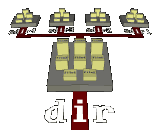
fsv (pronounced eff-ess-vee) is a file system visualizer in cyberspace. It lays out files and directories in three dimensions, geometrically representing the file system hierarchy to allow visual overview and analysis. fsv can visualize a modest home directory, a workstation's hard drive, or any arbitrarily large collection of files, limited only by the host computer's memory and graphics hardware.
Two different 3D representation schemes are offered:
 MapV view. This represents files and directories
as rectangular blocks, all of equal height, and each with area
proportional to the size of the corresponding file. Everything is laid out
on top of its parent directory, somewhat like a Venn diagram in 3D. In the
sample at left, the yellow blocks are regular files, and the grey blocks
underlying them are directories. The root directory is the block at the
bottom.
MapV view. This represents files and directories
as rectangular blocks, all of equal height, and each with area
proportional to the size of the corresponding file. Everything is laid out
on top of its parent directory, somewhat like a Venn diagram in 3D. In the
sample at left, the yellow blocks are regular files, and the grey blocks
underlying them are directories. The root directory is the block at the
bottom.
 TreeV view. Built around a more conventional
tree/leaf paradigm, this view represents directories as interconnected
platforms, with leaves (files et al.) sitting on top. Everything is
arranged concentrically, with the root directory closest to the center and
subdirectories farther out. The leaf blocks all have the same footprint,
and vary in height according to the corresponding file size.
TreeV view. Built around a more conventional
tree/leaf paradigm, this view represents directories as interconnected
platforms, with leaves (files et al.) sitting on top. Everything is
arranged concentrically, with the root directory closest to the center and
subdirectories farther out. The leaf blocks all have the same footprint,
and vary in height according to the corresponding file size.
fsv combines either of these 3D views with a standard 2D directory tree / file list interface, offering the best of both viewing paradigms. Directories can be expanded (shown) and collapsed (hidden) at will, allowing as much or as little of the file system to be visible at any given time.
More fsv screen shots are available here.
Requirements
To run fsv, you will need:
- A Unix/Linux workstation running the X Window System
- Dedicated 3D graphics hardware (okay, not required but it really helps)
- OpenGL 1.1 or newer, or Mesa3D libraries.
Links
fsv was partly inspired by fsn, the experimental 3D File System Navigator developed some time ago by Silicon Graphics. This program figured prominently in a scene from Steven Spielburg's hit film, Jurassic Park.
The author of fsv has also created Light Speed!, a program which simulates the bizarre optical effects of relativistic velocities on ordinary objects.
Author
fsv was written by Daniel Richard G., a former student of Computer Science at the Massachusetts Institute of Technology. High-end visualization stuff fascinates him.
fsv is copyright © 1999 by Daniel Richard G.

![[Main]](img/main-cur.png)
![[Screen shots]](img/screenshots-0.png)
![[Download]](img/download-0.png)
